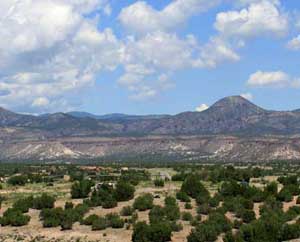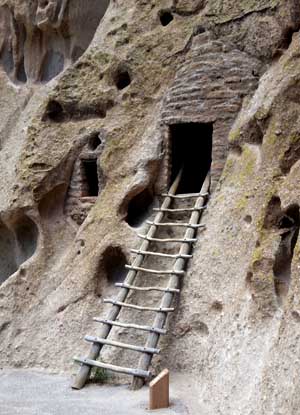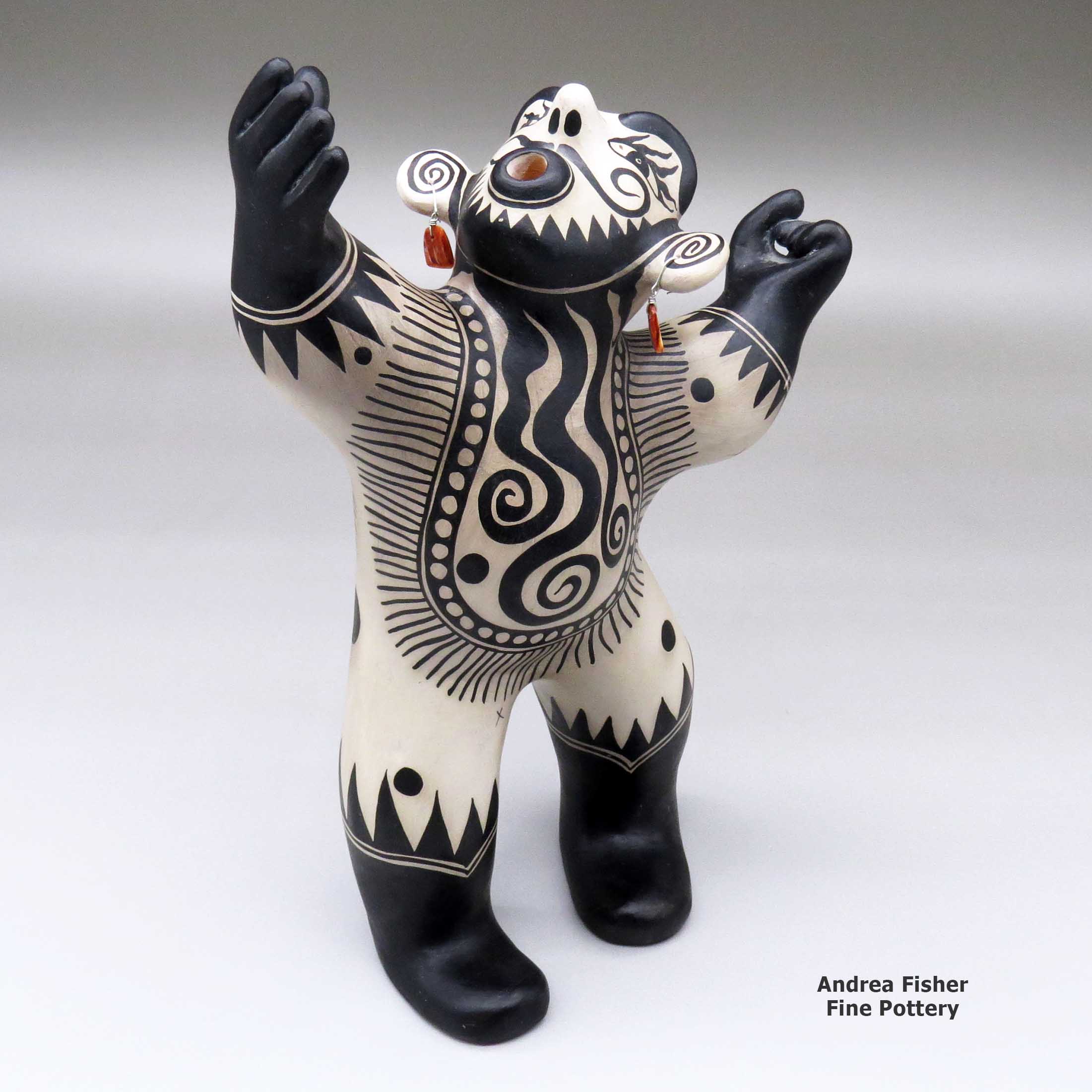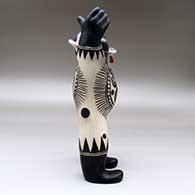
Virgil Ortiz
Cochiti
Virgil Ortiz was born into the Oak Clan of Cochiti Pueblo in May 1969. His parents were Seferina and Guadalupe Ortiz, his grandmother was Laurencita Herrera. Both Seferina and Laurencita were well-known potters and Virgil grew up watching them work with clay. During those years, Virgil's mother also taught him and all six of his siblings how to find and process the clay and how to find and prepare the native plants used in the making and decorating of Cochiti Pueblo pottery. She taught them how to work the clay, create different shapes and forms, paint designs and ground fire their pieces when they were done.
Virgil became interested at an early age, making his first storyteller when he was only 6. He went from that to Santa Fe Indian Market where his first entry to the jury earned him a 1st Place ribbon (Student, 18 years or younger) in 1983 when he was 14. He earned ribbons almost every year until he stopped showing at Santa Fe Indian Market in 2001. He's been back since, earning the 1st Place ribbon for figures at the 2019 Santa Fe Indian Market.
Virgil likes to make everything from traditional jars to tattooed circus, science fiction and historical figures. The forms he draws on range from circus performers to opera divas to religious figures to the Conquistadors. The designs he likes to paint are also a mix of traditional and non-traditional, integrating Pueblo history and culture with apocalyptic themes, science fiction and stories of his own. In 2017, Virgil provided 31 figures for a solo exhibit at the Denver Art Museum called "Revolt 1680/2180: Virgil Ortiz." It was the high point of his story line relating to the Pueblo Revolt of 1680, the first true American Revolution. In 1680, after decades of religious persecution and physical abuse the Pueblo people rose up and threw the Spanish out of New Mexico.
Virgil's artistic interests have also branched well beyond the world of pottery into designing textiles, fashions and jewelry, fashion photography and video production. Virgil also lately created a series of figures that became 3D models for an animated Disney feature film.
"Clay is the core of my creations," he says. "My work centers on preserving traditional Cochiti culture and art forms. It's important to recognize that Pueblo communities are very much alive and have a level of vitality that speaks to generations of strength, persistence, brilliance and thriving energy."
In 2023, Virgil was awarded the Tony Da Memorial Award "New Visions in Pueblo Pottery" at the Santa Fe Indian Market.
Exhibits that have Featured Works by Virgil
- Behind the Mask: Indigenous Artists Speak Out. Heard Museum. Phoenix, Arizona. Ongoing Exhibit October 2020
- Virgil Ortiz: Revolution - Rise Against the Invasion. Colorado Springs Fine Arts Center at Colorado College. Colorado Springs, Colorado. October 6, 2018 - January 6, 2019
- Virgil Ortiz Jewelry. King Galleries. Santa Fe, New Mexico. August 15-20, 2017
- Virgil Ortiz: Taboo, New Works in Clay. King Galleries. Santa Fe, New Mexico. July 21, 2017 - August 11, 2017
- Virgil Ortiz: Taboo, New Works in Clay. King Galleries. Scottsdale, Arizona. Opened April 20, 2017
- Beauty Speaks for Us. Heard Museum. Phoenix, Arizona. February 10, 2017 - March 31, 2017
- An Evening Redness in the West. Museum of Contemporary Native Arts. Santa Fe, New Mexico. August 21, 2015 - December 31, 2015
- Super Heroes: Art! Action! Adventure! Heard Museum. Phoenix, Arizona. May 16, 2015 - August 23, 2015
- American Indian Fashion: From Lloyd Kiva New to Now. Heard Museum North. Scottsdale, AZ. November 21, 2013 - April 30, 2014
- That's The Way I Like It. Heard Museum. Phoenix, AZ. April 26, 2014 - Februyary 8, 2015
- Pop! Popular Culture in American Indian Art. Heard Museum. Phoenix, AZ. April 16, 2010 - April 10, 2011
- Choices and Change: American Indian Artists in the Southwest. Heard Museum North. Scottsdale, AZ. June 30, 2007 - April 30, 2014
- Sole Stories: American Indian Footwear. Heard Museum. Phoenix, AZ. October 21, 2006 - October 20, 2007
- Gifts to Celebrate. Heard Museum. Phoenix, AZ. October 8, 2005 - July 30, 2006
- Home: Native People in the Southwest. Heard Museum. Phoenix, AZ. 2005
- Virgil Ortiz: La Renaissance Indigene. Heard Museum. Phoenix AZ. October 2004 - June 5, 2005
- Blue Rain Gallery 2000. Blue Rain Gallery. Fort Mason, San Francisco, CA. March 24, 2000 - March 26, 2000
- Earth, Hands, Life: Southwestern Ceramic Figures. Heard Museum. Phoenix, Arizona. April 1988 - April 1989
Some Awards Won by Virgil
- 2018 Santa Fe Indian Market, Classification II - Pottery, Division B - Traditional Painted Pottery, Category 605 - Figures/Manas: First Place
- 2017 Santa Fe Indian Market: Classification II - Pottery, Division B - Traditional, Category 603 - Painted polychrome pottery in the style of Cochiti, Santo Domingo, Santa Clara, San Ildefonso, Tesuque, Nambe, San Juan, Pojaque, any form: Second Place
- 2007 Heard Museum Guild Indian Fair & Market, Classification II - Pottery, Division D - Traditional, Native Clay, Hand Built, Figurative: Second Place
- 2006 Heard Museum Guild Indian Fair & Market. Heard Museum. Phoenix, AZ. Class. VI - Textiles/weavings/clothing, Div. E - Non-traditional attire woven or sewn, Honorable Mention; Two Judge's Choice Awards
- 2005 Heard Museum Guild Indian Fair & Market, Classification VIII - Pottery, Division C - Traditional/Native Clay/Hand-Built/Figurative: Best of Division. Awarded for figurative work which is untitled
- 2005 Heard Museum Guild Indian Fair & Market: Judge's Choice Award. Awarded by judge Peter Held for figurative work which is untitled
- 2005 Heard Museum Guild Indian Fair & Market Signature Artist
- 2004 Santa Fe Indian Market. Santa Fe, NM. Class. II - Pottery, Div. E -Traditional pottery, jars, including wedding jars, Best of Division
- Cat. 1204 - Jars, Santo Domingo or Cochiti, First Place - 2004 Heard Museum Guild Indian Fair & Market. Heard Museum, Phoenix, AZ. Class. VIII - Pottery, Div. C - Traditional/native clay/hand-built/figurative, Honorable Mention
- 1993 Santa Fe Indian Market. Santa Fe, NM. Class. II - Pottery, Div. G - Traditional pottery/painted designs on matte or semi-matte surface, all forms except jars, Cat. 1408 - Storytellers (all one piece), First Place
- 1992 Santa Fe Indian Market. Santa Fe, NM. Class. II - Pottery, Div. G - Traditional pottery/painted designs on matte or semi-matte surface, all forms except jars, Cat. 1411 - Other figures (all one piece), First Place
- 1991 Santa Fe Indian Market. Santa Fe, NM. Class. II - Pottery, Div. G - Traditional pottery/painted designs on matte or semi-matte surface, all forms except jars, Cat. 1408 - Storytellers (all one piece), Third Place
- Cat. 1411 - Other figures (all one piece), Third Place
- Class. III - Paintings, drawings and graphics; Div. D - Drawings, Cat. 2102 - Realistic style, First Place - 1990 Santa Fe Indian Market. Santa Fe, NM. Class. II - Pottery, Div. G - Traditional pottery, painted designs on matte or semi-matte, all forms but jars, Cat. 1216 - Other figures (all one piece), First Place
- Cat. 1213 - Storytellers (all one piece), First Place - 1989 Santa Fe Indian Market. Santa Fe, NM. Class. III - Paintings, drawings and graphics, Div. B - Painting-two dimensional, non-southwest style, Cat. 1707, Drawings, First Place
- 1983 Santa Fe Indian Market. Santa Fe, NM. Class. VI - (18 yrs. and under), Div. A - Ages 13 through 18, First Place
100 West San Francisco Street, Santa Fe, New Mexico 87501
(505) 986-1234 - www.andreafisherpottery.com - All Rights Reserved

Cochiti Pueblo

View west across Cochiti Pueblo
Cochiti Pueblo lies fifteen miles south of Santa Fe along the west bank of the Rio Grande. Frijoles Canyon in what is now Bandelier National Monument is the site of the pueblo's most recent ancestral home. The Eastern Keresans may have relocated to the Bandelier area from the Four Corners region around 1300.
Cochiti legend says that Clay Old Woman and Clay Old Man came to visit the Cochitis. While all the people watched, Clay Old Woman shaped a pot. Clay Old Man danced too close and kicked the pot. He rolled the clay from the broken pot into a ball, gave a piece to all the women in the village and told them never to forget to make pottery.

At Bandelier National Monument
In prehistoric times, human effigy pots, animals, duck canteens and bird shaped pitchers with beaks as spouts were common productions of the Cochiti potters. Many of these were condemned as idols and destroyed by the Franciscan priests. That problem stopped when the Spanish left in 1820 but the fantastic array of figurines created by Cochiti potters was essentially dormant until the railroad arrived. Then Cochiti potters were among the first to enter the tourist market and they produced many whimsical figures into the early 1900s. Then production followed the market into more conventional shapes.
Legend has it that a Ringling Brothers Circus train broke down near Cochiti Pueblo in the 1920s. Supposedly, the tribe's contact with the ringmaster, trapeze artists, opera singers, sideshow quot;freaks" and exotic animals paved the way for a variety of new figural subjects. However, shortly after the railroad passed through, a delegation of Cochiti men got on the train and traveled to Washington DC. There they were introduced to the President, spoke to Congress, and were taken on a tour of the "highlights" of American civilization in Washington and in New York City, incuding the Metropolitan Opera, the Bronx Zoo and a performance of the Ringling Brothers Circus. As none of the men could read or write, nor draw, what they brought back to Cochiti was what they remembered of things they had never seen before. The stories they told must have been wild. An astute observer will find angels, nativities, cowboys, tourist caricatures, snakes, dinosaurs, turtles, goats, two-headed opera singers, clowns, tattooed strongmen, Moorish nuns and even mermaids in the Cochiti pottery pantheon, many produced only since the early 1960s and based on characters described in Cochiti's oral history.
A few modern potters make traditional styled pots with black and red flowers, animals, clouds, lightning and geometric designs but most Cochiti pottery artists now create figurines. Most notable is the storyteller, a grandfather or grandmother figure with "babies" perched on it. Helen Cordero is credited with creating the first storyteller in 1964 to honor her grandfather. The storyteller style was quickly picked up by other pueblos and each modified the form to match their local situation (ie: clay colors and tribal and religious traditions). In some pueblos, storytellers are also now made as drummers and as a large variety of animals.
Today, Cochiti potters face the challenge of acquiring the clay for the white slip. Construction of Cochiti Dam in the 1960s destroyed their primary source of their trademark white slip and gray clay. Now the white slip comes from one dwindling source at Santo Domingo, Cochiti Pueblo's neighbor to the south.
Most outsiders who visit Cochiti Pueblo these days do so on the way to or from either the recreation area on Cochiti Lake or Kasha-Katuwe Tent Rocks National Monument.
100 West San Francisco Street, Santa Fe, New Mexico 87501
(505) 986-1234 - www.andreafisherpottery.com - All Rights Reserved


Virgil Ortiz, Cochiti, Largeblack-on-whitestandingoperasingerfiguredecoratedwithgeometricdesigns,originalearringshavebeenreplaced
Cochiti
$ 4200
gmco4a135
Large black-on-white standing opera singer figure decorated with geometric designs, original earrings have been replaced
4.25 in L by 8.75 in W by 13.75 in H
Condition: Very good, rubbing on feet and arm, pencil marks on foot, slip chip on finger, marks and scratches on head
Signature: Vigil Ortiz Cochiti Pueblo
Date Created: 1999
100 West San Francisco Street, Santa Fe, New Mexico 87501
(505) 986-1234 - www.andreafisherpottery.com - All Rights Reserved

Laurencita Herrera Family Tree
Disclaimer: This "family tree" is a best effort on our part to determine who the potters are in this family and arrange them in a generational order. The general information available is questionable so we have tried to show each of these diagrams to living members of each family to get their input and approval, too. This diagram is subject to change should we get better info.
-
Laurencita Herrera (1912-1984) & Nestor Herrera
- Mary Frances Herrera (1935-1991)
- Dorothy Herrera (1969-)
- Edwin Herrera (1966-) & Mary Herrera
- Mary Ramona Herrera (1970-)
- Seferina Ortiz (1931-2007) & Guadalupe Ortiz
- Joyce Ortiz Lewis (1954-)
- Leslie Lewis
- Mary Janice Ortiz (1956-)
- Kimberly Walker (1978-)
- Juanita Inez Ortiz (1960-2008)
- Krystal Ortiz (1987-)
- Lisa Holt (1980-) & Harlan Reano (1976-)(Santo Domingo)
- Virgil Ortiz (1969-)
- Leon Ortiz & Jackie Ortiz
- Amanda Ortiz (1988-)
- Joyce Ortiz Lewis (1954-)
Some of the above info is drawn from Southern Pueblo Pottery, 2000 Artist Biographies, by Gregory Schaaf, © 2002, Center for Indigenous Arts & Studies
Other info is derived from personal contacts with family members and through interminable searches of the Internet and cross-examination of the data found.
(505) 986-1234 - www.andreafisherpottery.com - All Rights Reserved



